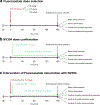Succinate prodrugs as treatment for acute metabolic crisis during fluoroacetate intoxication in the rat
- PMID: 36282352
- PMCID: PMC10540239
- DOI: 10.1007/s11010-022-04589-9
Succinate prodrugs as treatment for acute metabolic crisis during fluoroacetate intoxication in the rat
Abstract
Sodium fluoroacetate (FA) is a metabolic poison that systemically inhibits the tricarboxylic acid (TCA) cycle, causing energy deficiency and ultimately multi-organ failure. It poses a significant threat to society because of its high toxicity, potential use as a chemical weapon and lack of effective antidotal therapy. In this study, we investigated cell-permeable succinate prodrugs as potential treatment for acute FA intoxication. We hypothesized that succinate prodrugs would bypass FA-induced mitochondrial dysfunction, provide metabolic support, and prevent metabolic crisis during acute FA intoxication. To test this hypothesis, rats were exposed to FA (0.75 mg/kg) and treated with the succinate prodrug candidate NV354. Treatment efficacy was evaluated based on cardiac and cerebral mitochondrial respiration, mitochondrial content, metabolic profiles and tissue pathology. In the heart, FA increased concentrations of the TCA metabolite citrate (+ 4.2-fold, p < 0.01) and lowered ATP levels (- 1.9-fold, p < 0.001), confirming the inhibition of the TCA cycle by FA. High-resolution respirometry of cardiac mitochondria further revealed an impairment of mitochondrial complex V (CV)-linked metabolism, as evident by a reduced phosphorylation system control ratio (- 41%, p < 0.05). The inhibition of CV-linked metabolism is a novel mechanism of FA cardiac toxicity, which has implications for drug development and which NV354 was unable to counteract at the given dose. In the brain, FA induced the accumulation of β-hydroxybutyrate (+ 1.4-fold, p < 0.05) and the reduction of mitochondrial complex I (CI)-linked oxidative phosphorylation (OXPHOSCI) (- 20%, p < 0.01), the latter of which was successfully alleviated by NV354. This promising effect of NV354 warrants further investigations to determine its potential neuroprotective effects.
Keywords: Cell-permeable succinate; Emergency medicine; Fluoroacetate; Mitochondria; Toxicity.
© 2022. The Author(s), under exclusive licence to Springer Science+Business Media, LLC, part of Springer Nature.
Conflict of interest statement
Declarations
Figures





References
MeSH terms
Substances
Grants and funding
LinkOut - more resources
Full Text Sources

